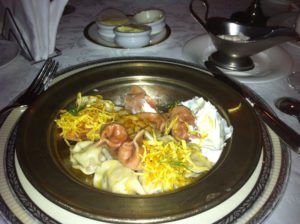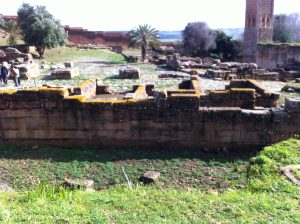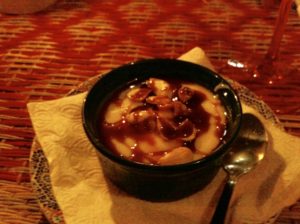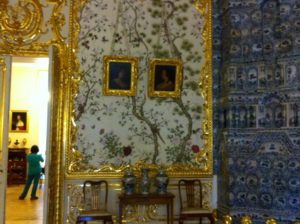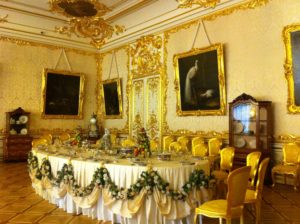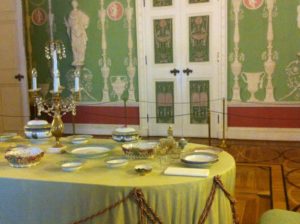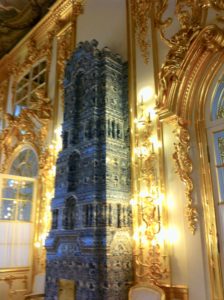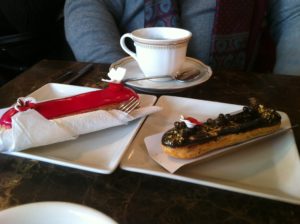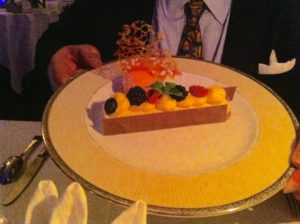This blog will take you to places you’ve always wanted to see and to some you may only have heard of. Its purpose – to immerse you in extraordinary tastes and colors, smells, sights and experiences, infecting you, or perhaps aggravating, an already serious case of wanderlust.
Many thanks for visiting Foreign Writes. Your comments are always welcome. Hope you’ll be back soon!
To view comments or to leave one, please click on the title of the post. Click on photos to enlarge.
Morocco — Rabat — Our Crash Course
We’ll spend the next two days absorbing Moroccan basics under the guidance of the Center for Cross Cultural Learning (CCCL). Founded by professors at Mohammed V University, they specialize in providing study abroad programs for U.S. colleges and also organize Road Scholar trips.
We meet Rachid and Wadid, both doctoral history students, who will be with the 20 of us for the whole adventure. There are lectures from university professors on Moroccan history and politics, architecture, the roles of women and the veil, and Islam in Morocco.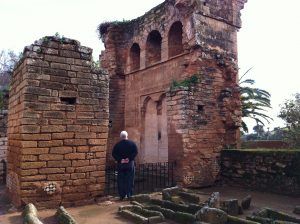
We explore the walled labyrinth of the Medina, and then visit ruins of the Roman town, Sala Colonia, dating from 40 A.D., over which a Merinid
town grew, only to be abandoned in 1154, and to become, in the 14th century, a necropolis for the Sultan of the day. Storks nesting on top of the remaining walls have it all to themselves now.
Of course we don’t go hungry. CCCL has a staff of excellent cooks to introduce us to that vital aspect of the country. Our first dinner features another 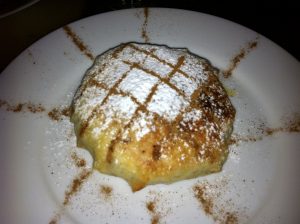 iconic Moroccan dish — Pastilla — chicken, almonds and many spices baked in puff pastry and sprinkled with powdered sugar and cinnamon.
iconic Moroccan dish — Pastilla — chicken, almonds and many spices baked in puff pastry and sprinkled with powdered sugar and cinnamon.
Following dinner we’re entertained by musicians playing the Andalusian music brought to Morocco by those fleeing the reconquest of Spain from the Arabs in 1492. Listen here IMG_2558
Tomorrow we’ll be on the road to Chefchaouen, the blue city, then on to Fes, across the Atlas mountains to Erfoud, Merzouga and Quarzazate, and back across the mountains to Marrakech.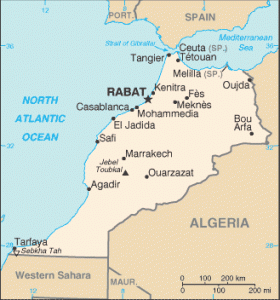
We still have a lot to learn.
Morocco — Rabat — A First Taste
A relief to land in Rabat, Morocco’s capital, after thirteen hours of flying and a four hour layover in Paris. The bright February sun and temps in the 70’s are also welcome, and just what we’d hoped to escape to.
It’s a white city of four and five story buildings, the wide main boulevard, Avenue Mohammed V, features a row of towering palms marching down its middle. That’s where we find our hotel, the appropriately named Terminus, a block away from the main railway station. We’ve come two days before our two-week Road Scholar program begins to do some exploring on our own and, we hope, get over the worst of jet lag. Our first priority is dinner – somewhere close by that we can walk to without getting totally lost. Tagine wa Tanja looks promising.
Stepping down into the dining room takes us out of what could pass for a provincial capital in southern France, and into the Morocco of our imaginations. We’re greeted by candle light and the music of an oud player sitting cross legged close to a fireplace’s glowing embers. There are only half a dozen tables, and they’re dressed in the same apricot silk that covers the walls.
It’s Friday night, when couscous is the traditional dish. Mark orders the ‘royal’ version. We’re not sure just what that means, but how can you go wrong? I opt for a tagine of chicken cooked with pears and walnuts. Tagines are the signature dishes of Moroccan cooking, named after the two-part utensil they’re cooked in. The contents of a shallow clay pot, filled with combinations of vegetables or fruits, meats, and a variety of spices, are covered with a conical hat that lets out the steam, then slow-cooked over embers.
We find out what royal means when they bring Mark’s towering platter.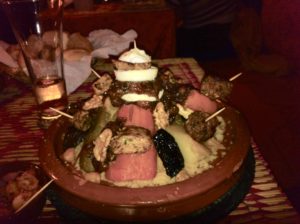
Mine is more manageable, but equally delicious.
Desert is a rich custard,
A diner at the neighboring table introduces himself. He’s headmaster of a boarding school in the interior, and wants to welcome us on our first night in his country.
We retrace our steps, and find the palms of Avenue Mohammed V twinkling with the baby-blue lights that wrap their trunks.
We’re actually here! Morocco. Magic.
Russia – St. Petersburg – Saving the Best For Last
Foreign Writes apologizes for the long gap in posts.
There’s one more glorious gem in St. Petersburg’s crown – perhaps the best of all – the Hermitage collection of impressionist and post-impressionist masterpieces. In 2014 it moved from the main Hermitage palace across Palace Square, the vast parade ground, to its very own museum constructed within the former General Staff Building.IMG_1563
 The museum itself is a work of art. Behind the neoclassical facade the four interior courtyards of the building have been glass-roofed. We walk through this light filled space and up a glass staircase to reach a plain wooden door that gives no hint of what it conceals, and makes all the more surprising the treasures behind it.
The museum itself is a work of art. Behind the neoclassical facade the four interior courtyards of the building have been glass-roofed. We walk through this light filled space and up a glass staircase to reach a plain wooden door that gives no hint of what it conceals, and makes all the more surprising the treasures behind it.
Room after room of paintings by every French master from the earliest 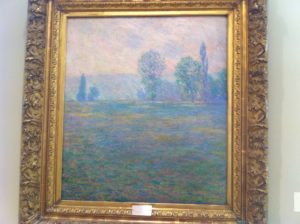 days of impressionism to its successors. Not the few examples per artist that most major museums display, but several rooms devoted to each master. Our mouths are open. We’re speechless as we wander. So many of these wonders have never been exhibited in the West – many not even documented in ordinary art books.
days of impressionism to its successors. Not the few examples per artist that most major museums display, but several rooms devoted to each master. Our mouths are open. We’re speechless as we wander. So many of these wonders have never been exhibited in the West – many not even documented in ordinary art books.
Where did they come from?
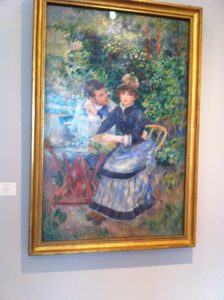 Following the 1917 revolution, Lenin nationalized the collections of Sergei Shchukin and Ivan Morozov, among the earliest collectors of the impressionists. Shchukin’s amazing collection of 258 paintings counted, among others,
Following the 1917 revolution, Lenin nationalized the collections of Sergei Shchukin and Ivan Morozov, among the earliest collectors of the impressionists. Shchukin’s amazing collection of 258 paintings counted, among others,
7 Rousseau
37 Matisse
51 Picasso
14 Monet
16 of Gauguin as well as multiples of Cezanne, Van Gogh, Renoir and many others.
Among Ivanov’s 240 French works were 20 Cezannes, and numerous 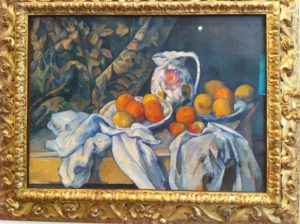 paintings by Pissarro, Degas, and more. These works formed the basis of the State Museum of New Western Art until, in 1948, Stalin ordered them put in storage, calling them decadent and bourgeois. They were not exhibited again until the 1960s.
paintings by Pissarro, Degas, and more. These works formed the basis of the State Museum of New Western Art until, in 1948, Stalin ordered them put in storage, calling them decadent and bourgeois. They were not exhibited again until the 1960s.
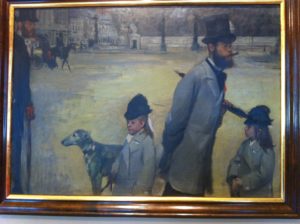 The other major additions to the collection were the 74 paintings, exhibited for the first time in 1995, from among the 200,000 paintings taken as war reparations from Germany by the retreating Russian army, and hidden for 50 years. 56 of them come from the private collection of textile magnate Otto Krebs, and had never been exhibited. They include 15 Renoirs and works by Degas, Van Gogh, Gauguin, Delecroix, Matisse, Monet, Pissarro and Toulouse-Lautrec.
The other major additions to the collection were the 74 paintings, exhibited for the first time in 1995, from among the 200,000 paintings taken as war reparations from Germany by the retreating Russian army, and hidden for 50 years. 56 of them come from the private collection of textile magnate Otto Krebs, and had never been exhibited. They include 15 Renoirs and works by Degas, Van Gogh, Gauguin, Delecroix, Matisse, Monet, Pissarro and Toulouse-Lautrec.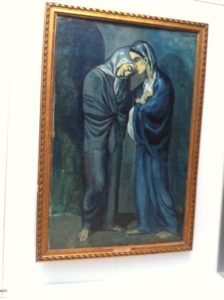
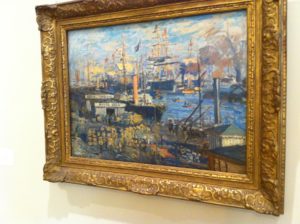 To walk through room after room is to have your breath taken away as you discover yet more treasures. An experience not to be missed, if possible.
To walk through room after room is to have your breath taken away as you discover yet more treasures. An experience not to be missed, if possible. 
There’s much more to St. Petersburg. I haven’t even mentioned the music and dance. But it’s time to move on. I leave you with one last Russian bon-bon. I dare you to keep from smiling as you watch it. The locale is the vast plaza of Moscow University that overlooks the city. Enjoy.
Next up – Morocco.
Russia – St. Petersburg – Catherine’s Summer Place
Click on photos to enlarge.
Although named after Catherine I, wife of Peter the Great, the Catherine Palace in Pushkin outside St. Petersburg is usually associated with the second Catherine, Catherine the Great. Born Sophia, a Prussian princess, her marriage to the heir to the Russian throne was arranged early. She was 10 when she first met Peter of Holstein-Gottrup. She found him repulsive. At sixteen she became his wife. Seventeen years later, in 1762, he was crowned Peter III on the death of his mother, the Empress Elizabeth. He reigned for only six months before being toppled in a coup d’etat organized by Catherine and her followers. A few days later he was strangled by the brother of Catherine’s then lover, Grigory Orlov, and Catherine proclaimed herself Empress, ruler of all Russia.
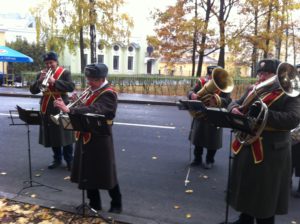 As we pull up to the palace, we’re greeted by a group of musicians in Soviet army uniforms playing New York, New York. Sureal.
As we pull up to the palace, we’re greeted by a group of musicians in Soviet army uniforms playing New York, New York. Sureal.
The palace, surrounded by a huge park, was a summer retreat for the tzars. We get a tantalizing glimpse through the ornate gilded 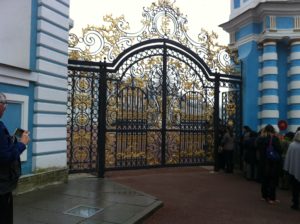 gates, but are hardly prepared for the over-the-top facade and the
gates, but are hardly prepared for the over-the-top facade and the  immensity of the structure. 220 pounds of gold decorate the exterior. IMG_1468
immensity of the structure. 220 pounds of gold decorate the exterior. IMG_1468
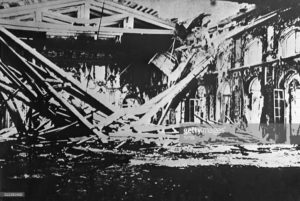
The palace was destroyed before the Nazi’s retreated, leaving only a shell. The Great Hall.
Careful descriptions and drawings were made before the war, and artists and craftspeople were able to reconstruct its glory. And it IS glorious. Have a look at a few of its hundreds of rooms. Here’s a video of the reconstructed Great Hall – 1000 gilded square meters.IMG_1476
Russia – At Home in St. Petersburg
Here’s a link from a writer friend to a wonderful poem about the Hermitage during WWII. Do have a look. https://www.poetryfoundation.org/poems-and-poets/poems/detail/47104
We’re on our own here for five days. We’re booked into the Rossi Boutique Hotel. Situated on the Fontanka River embankment, the building was once a private residence and is now a funky hotel whose rooms retain the feel of bygone elegance. 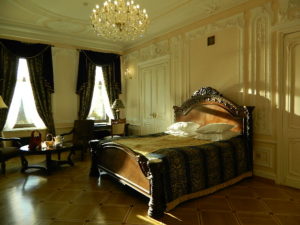 Not your standard layout- we climb up stairs and down stairs to get to our room.
Not your standard layout- we climb up stairs and down stairs to get to our room.
We’re a short walk to Nevsky Prospect. Laid out by Peter the Great in 1701, it’s still the heart of St. Petersburg. The city is full of 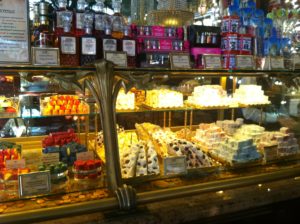 coffee shops, but none rivals the Eliseyev Emporium. The art deco building has been restored to its early glory. As we enter, we’re greeted by a grand piano playing classical music – on its own. Walls are lined with displays showcasing everything from caviar
coffee shops, but none rivals the Eliseyev Emporium. The art deco building has been restored to its early glory. As we enter, we’re greeted by a grand piano playing classical music – on its own. Walls are lined with displays showcasing everything from caviar  to cheeses to liquors to exquisitely decorated pastries.
to cheeses to liquors to exquisitely decorated pastries.
We take a seat at one of the red velvet banquets and order hot chocolate and eclairs. The hot chocolate is so thick we use our spoons to eat it. The eclairs are miniature works of art. Note gold dust on the chocolate.
St. Petersburg is a city made for walking – for all ages. We discover Le Pont Rouge – the 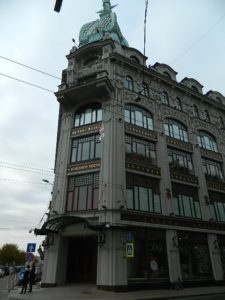 red bridge – and the very upscale department store of the same name. It’s an art deco gem. Inside is a curated selection of designer fashion. We’re just as impressed by the number of beefy security guys wandering the floors. At least we can afford a coffee in
red bridge – and the very upscale department store of the same name. It’s an art deco gem. Inside is a curated selection of designer fashion. We’re just as impressed by the number of beefy security guys wandering the floors. At least we can afford a coffee in 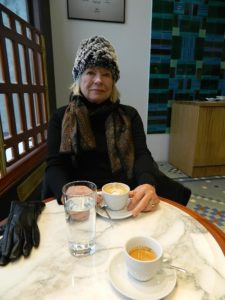 the swanky cafe.
the swanky cafe.
Our big splurge is dinner at Palkin. We’re greeted on the ground floor by a St. Petersburg beauty in impossibly high heels. She leads us up a glass staircase, lighted from below, to the dining room – all 19th century opulence.
I can’t resist the caviar selection – five varieties accompanied by blini.
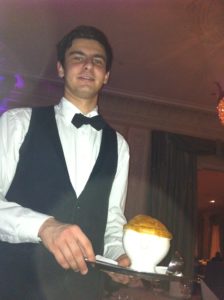 Mark starts with the 16 hour cabbage soup delivered by our cute waiter.
Mark starts with the 16 hour cabbage soup delivered by our cute waiter.
I have palmeni, tiny dumplings.